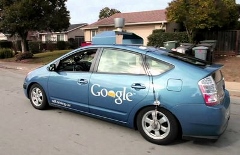by James A. Bacon
There is an extraordinary level of hubris in the world of transportation and land use planning. Planners in state transportation departments, including Virginia’s, advance mega-highway projects based upon forecasts of what transportation demand will be two or three decades from now. My friends in the Smart Growth camp rightly reject many of these asphalt dinosaurs, but they then turn around and, with equal confidence, espouse equally expensive infrastructure for mass transit and high-speed rail based upon their own vision of the ideal transportation system.
At this moment in time, the Smart Growth crowd looks smarter than the highway infrastructure crowd. Road travel has declined markedly since peaking in the mid-2000s, and there appears to be greater demand for mass transit. Companies that bet big on rising traffic volumes have lost big. Here in Virginia, we need look no farther than the Dulles Greenway and the Pocahontas Parkway, where investors lost their shirts, and to the Interstate 495 Express Lanes, where toll-paying traffic has been slower to materialize than expected. How anyone can justify new billion-dollar highway projects in the current environment is beyond me.
That’s not to say that the future necessarily belongs to mass transit. The fact is, nobody knows. The transportation sector is undergoing the most convulsive revolution since the invention of the automobile and anybody who tells you they know how it’s all going to shake out is either a fool or a liar.
In support of that statement, I present three data points from my blog reading this morning. These stories highlights emerging trends that have yet to seep into the thinking of transportation bureaucrats, elected officials or even Smart Growth advocates.
- Google is moving full speed ahead with its plans to build a self-driving car. While Google’s core strength is writing software for the cars, the company is holding talks with auto manufacturers to build cars to its specifications. Google is exploring the idea of entering the market through robo-taxi systems, in which a fleet of self-driving cars would pick up passengers and commuters on demand, according to technology writer Jessica Lessin.
- The first electric bike store in the Arlington area, Hybrid Pedals, will open in September. The store will sell electric bikes that can travel 20 to 30 miles on a single electric charge, giving riders the option of extending the range by pedaling, reports ARL Now.
- New York City is applying information technology to transform its transportation system — instrumenting traffic lights to manage traffic in real time, paying for parking with smart phones and installing cameras to catch speeders in school zones, says Janett Sadik-Khan, NYC’s transportation commissioner in a UDM Cities videoclip.
New technologies are transforming everything relating to transportation, from roads and mass transit to parking and traffic light sequencing. Venture capitalists are rolling out new business models. The so-called “sharing” economy is challenging the bedrock assumption that people need to own their own cars.
Transportation and land use are extraordinarily complex systems, and people are deluding themselves if they think they know where all this innovation will take us. Would driving become a more attractive option if cars steered themselves and people spent their commute time reading email or surfing the web? Would bicycling become more popular if electric bikes allowed people to travel faster with less exertion? Would people still take the bus if they could hail jitneys with their smart phones instead? Or would the ability to track the next bus’ arrival at a nearby bus top make that transportation mode more competitive?
What about non-transportation technologies that will effect driving patterns? Today, video conferencing is far less satisfying than a face-to-face meeting. What would happen if the quality improved to the point where people couldn’t tell the difference between being there and not? Would they travel less? Another conundrum: Technology allows white-collar workers to perform their jobs almost anywhere. The “office” has been reduced to a smart phone and laptop. Will people work more at home, driving less? Or will be they be free to work anywhere, meaning spending more time on the road?
Will people be driving more a decade from now, or less? Nobody knows. Indeed, the future is unknowable.
This is a spectacularly bad time to be placing multibillion-dollar bets on Big Infrastructure. We might bet right… but we might bet wrong. Given the breadth and speed of change, I would suggest, the odds of betting wrong are greater than ever.
Uncertainty is not an excuse to do nothing. But I would borrow from the thinking of Nassim Nicholas Taleb, author of “Antifragile,” to suggest that this is a time for small experiments, not grand ones. Experiment… collect feedback… modify experiment… Collect more feedback. Also, we need to build more flexibility into the transportation system. Systems that can readily accommodate themselves to new technologies and changes in demand will serve better than systems that can do only one thing.



